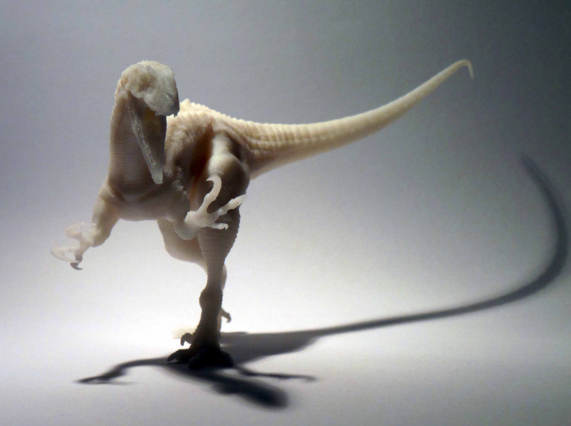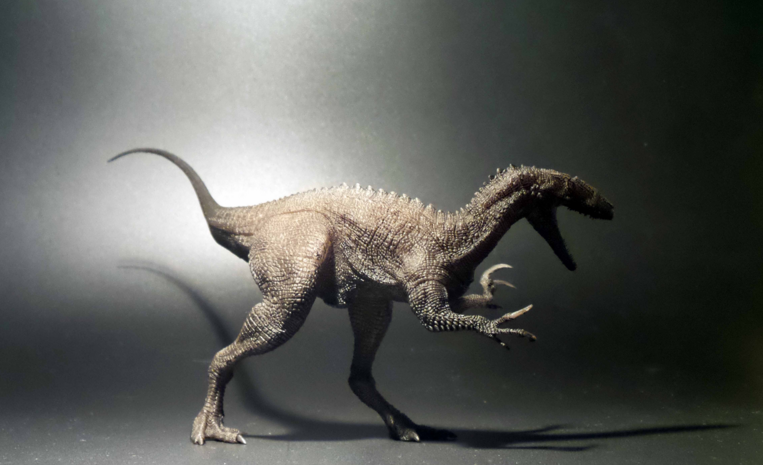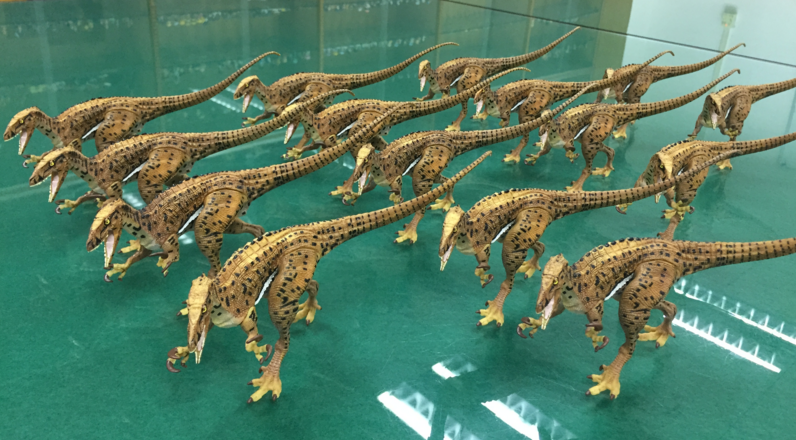Australia’s AAOD Museum & 3D Systems Produce 3D Printed Toy Replicas of Banjo the Dinosaur
 Finding a cache of ancient dinosaur bones: I think it’s one of those secret dreams we all harbor, especially as children, diligently digging in the dirt while fantasizing about the glory of being the next rock-star archaeologist, decked out with requisite khakis, neck kerchief, and even the friendly sidekick too.
Finding a cache of ancient dinosaur bones: I think it’s one of those secret dreams we all harbor, especially as children, diligently digging in the dirt while fantasizing about the glory of being the next rock-star archaeologist, decked out with requisite khakis, neck kerchief, and even the friendly sidekick too.
Might you find a dinosaur fossil in your lifetime? It’s not out of the realm of possibility, considering they are found everywhere it seems, even in the most banal contemporary locations. Just ask David Elliott about his experience, which allows many now to see his find, Banjo the theropod, in all his perfect glory at Australia’s AAOD Museum, along with other relatives like Elliott the sauropod. Thanks to 3D printing, Banjo, named after Australian bush poet Banjo Paterson, has been replicated as true to form as possible, following the wishes of Elliott who found him in 2009 in what could truly be considered his own backyard, on his sheep property near Winton, Queensland, Australia.
 According to a recent case study released by 3D Systems, Elliott, Executive Chairman of the Australian Age of Dinosaurs (AAOD) Museum, requested ‘nothing less than an immaculate recreation’ of Banjo, whose technical classification is that of the Australovenator wintonensis. Elliott did not want Banjo ill-represented as a toy or a dinosaur—and considering the magnificence of the find—on his own land—you can see why he would want to do a superior job in showing off the beast, as well as others down the line. With all that in mind, he requested a ‘finitely detailed master reference model’ in working with 3D Systems On Demand Manufacturing Quickparts services.
According to a recent case study released by 3D Systems, Elliott, Executive Chairman of the Australian Age of Dinosaurs (AAOD) Museum, requested ‘nothing less than an immaculate recreation’ of Banjo, whose technical classification is that of the Australovenator wintonensis. Elliott did not want Banjo ill-represented as a toy or a dinosaur—and considering the magnificence of the find—on his own land—you can see why he would want to do a superior job in showing off the beast, as well as others down the line. With all that in mind, he requested a ‘finitely detailed master reference model’ in working with 3D Systems On Demand Manufacturing Quickparts services.
During this project, 1,000 miniature models of Banjo were manufactured after the original 3D printed model was made. Scaled at 1:24, staring into his eyes, you can just imagine the therapod in his prime—fierce, lean, and agile—speeding through the Outback at 40 mph over 95 million years ago. Who doesn’t love dinosaurs? And the scarier the better! Thanks to the resolution offered by 3DS, museum goers in Australia now have the good luck to get a good look at one of these ancient creatures nearly all of us are endlessly fascinated by.
And just as the team at the AAOD Museum knows their dinosaur bones, they also employ a high level of technological savvy too. With that bit of expertise and dedicated commitment to showing off their local dinosaur finds in the best way possible, they had already used 3D printing for models—even life-size ones. Once the idea came along to make a high resolution, lifelike Banjo toy, Elliott and his team knew they needed extra help.
“A very highly detailed, computer-generated digital 3D model of Banjo had been created by paleo-artist Travis Tischler,” says Elliott. “The life-sized model is detailed to the point that every scale on the animal’s body is present. We wanted to capture this detail in the 22-centimeter-long toy so that every single wrinkle and scale was present in the final product.”
 As the project progressed, Tischler in working to help Elliott find the perfect fit for representing Banjo, suggested 3D Systems On Demand Manufacturing after touring their facilities in Melbourne and taking in the depth of their prototyping and manufacturing capabilities. In speaking with the team, he found that they had worked with others looking for the same type of work in terms of resolution and quality. Tischler was convinced they would be able to fulfill Elliott’s requirements—and he certainly was not off the mark.
As the project progressed, Tischler in working to help Elliott find the perfect fit for representing Banjo, suggested 3D Systems On Demand Manufacturing after touring their facilities in Melbourne and taking in the depth of their prototyping and manufacturing capabilities. In speaking with the team, he found that they had worked with others looking for the same type of work in terms of resolution and quality. Tischler was convinced they would be able to fulfill Elliott’s requirements—and he certainly was not off the mark.
The model for Banjo’s likeness was created on a 3D Systems ProJet 7000 HD SLA system using VisiJet SL FLEX material. This is obviously an extremely high quality, industrial tool when it comes to 3D printing, delivering an accuracy of 0.001 – 0.002 inch and very fast printing speeds.
According to 3DS, this technology includes 3D Manage software that provides:
- Easy job setup
- Build-optimization tools
- Parts stacking and nesting
- Job monitoring
With the choice of materials, in using VisiJet SL Flex, the dinosaur was recreated in flexible, polypropylene-like material, meant to be well-suited for the toy series.
“We were impressed by the quality and the quick delivery of the model,” says Elliott. “The result was perfect and achieved an exact miniature replica of the life-sized digital file.”
 Very serious about launching a formal toy line, once the model was completed and went through post-processing, the team sent it to a manufacturer in China who was able to make perfect replicas after creating plastic injection molds. The toys were actually hand-painted and readied for sale.
Very serious about launching a formal toy line, once the model was completed and went through post-processing, the team sent it to a manufacturer in China who was able to make perfect replicas after creating plastic injection molds. The toys were actually hand-painted and readied for sale.
This is just a start for Elliott, who plans now to work on an entire collection of toys, with three more coming out in the next year, to include:
- Diamantinasaurus – a sauropod that will be the largest toy at 46 cm long (1:32 scale)
- Muttaburrasaurus – an ornithopod that will also be printed at 1:32 scale
- Minmi – a small armored dinosaur that will be 18 cm long at 1:15 scale
Elliott and his wife Judy formed AAOD as a not-for-profit organization in 2002, upon finding a significant number of dinosaur fossils on their farmland. With this latest project, offering great potential for reproduction via 3D Systems, Elliott sees how much 3D printing can offer the museum and archiving world—not only in terms of scale but also larger and life-size replicas.
“There is a massive opening for reproductions in the museum world,” he says. “High-quality reproductions can now be made simply by scanning, digital modeling and 3D printing an exact replica. Once the replica has been painted to original colors it is virtually impossible to tell it apart from the original.”
“Animals can be digitally constructed in 3D or fossils and sculptures can be captured by 3D scanning and then 3D printed,” says Elliott. “Once the printed sections have been fitted together, you can produce an exhibit that once required a major sculpting job or a highly trained taxidermist.”
It’s of course, not surprising, that in partnering with 3D Systems the AAOD team is now part of a serious class act for starting a toy line. Many out there have ideas, but do not persevere to the same level in terms of getting the quality they envision and simply must have for a product. With this collaboration, we get to see a wonderful portrayal of a dinosaur we may not have been previously familiar with, as well as seeing how 3D scanning and 3D printing technology—along with on demand parts manufacturing—can have a serious impact on displays and exhibits not just for toymakers, but also for museums, archeology, and archiving, on numerous levels.
The AAOD Museum houses a massive collection of bones from Australia’s largest dinosaurs and operates one of the most-productive fossil preparation facilities in the Southern Hemisphere. It also offers tours and other public programs. What do you think of the plans for these 3D printed toys? Discuss in the 3D Printed Dinosaur Toys forum over at 3DPB.com.
Subscribe to Our Email Newsletter
Stay up-to-date on all the latest news from the 3D printing industry and receive information and offers from third party vendors.
Print Services
You May Also Like
New Business: Temporary, Migratory, & Modular 3D Printed Architecture
If we look at potentially emerging 3D printing businesses, then architecture has not been fully explored. Yes, there is a lot of house 3D printing going on worldwide. From deployable...
3D Printing News Briefs, April 19, 2025: Material Extrusion Standard, Metal Powder, & More
In today’s 3D Printing News Briefs, we’re covering a proposed standard for material extrusion, before moving on to business and metal powder. We’ll end with a commercial store’s robotic 3D...
Japan Unveils World’s First 3D Printed Train Station
Japan is now home to what we believe is the world’s first train station built with 3D printing technology. Located in Arida City, just south of Osaka, the new Hatsushima...
restor3d Raises $38M to Expand 3D Printed Orthopedic Implants
Backed by $38 million in new funding, restor3d is pushing ahead with the launch of four personalized implant lines, set to roll out in 2025 and 2026. This latest venture...


























